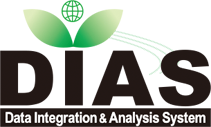


  |  |
| Name | AMY Project TRITON buoy dataset |
| Metadata Identifier | AMY_TRITON_buoy_dataset20230727070116-AMY20130909130838-DIAS20221121113753-en |
| Name | TRITON Office |
|---|---|
| Organization | JAMSTEC |
| Address | 2-15 Natsushima-cho, Yokosuka, Kanagawa, 237-0061, JAPAN |
| triton@jamstec.go.jp |
| Name | Prof. Jun Matsumoto, DSc |
|---|---|
| Organization | Dept. of Geography, Tokyo Metrop. Univ. |
| Address | Minami-Osawa 1-1, Hachioji, Tokyo, 192-0397, Japan |
| TEL | 042-677-2596 |
| FAX | 042-677-2596 |
| jun@center.tmu.ac.jp |
| Name | DIAS Office |
|---|---|
| Organization | Japan Agency for Marine-Earth Science and Technology |
| Address | 3173-25, Showa-Cho, Kanazawa-ku, Yokohama-shi, Kanagawa, 236-0001, Japan |
| dias-office@diasjp.net |
| Name | TRITON Office |
|---|---|
| Organization | JAMSTEC |
| triton@jamstec.go.jp |
| Name | TRITON Office |
|---|---|
| Organization | JAMSTEC |
| triton@jamstec.go.jp |
revision : 2012-02-07
Japan Agency for Marine-Earth Science and Technology (JAMSTEC) has developed Triangle Trans-Ocean Buoy Network (TRITON) buoy in 1998, and nearly 20 moorings have been deployed in the western tropical Pacific and eastern tropical Indian Ocean. These moorings in Pacific Ocean make Tropical Atmosphere Ocean (TAO)/TRITON array in cooperation with Pacific Marine Environmental Laboratory (PMEL) and National Data Buoy Center (NDBC) in National Ocean and Atmospheric Administration (NOAA) in United States. On the other hand, the moorings in Indian Ocean make Research moored Array for African-Asia-Australian Monsoon Analysis and prediction (RAMA) array as a multinational effort for Indian Ocean Observing System. These arrays are a part of Global Climate Observing system (GCOS), Global Ocean Observing System (GOOS) and Global Earth Observing System (GEOSS).
Each buoy measures temperature, salinity, mixed layer currents for oceanic variables, and wind temperature, relative humidity, barometric pressure, precipitation and short wave radiation for meteorological variables. These measured variables is essential for monitoring, understanding and forecasting of short-term climatic phenomena, such as El Nino and southern oscillation and Indian Ocean dipole event.
Data and graphic displays from these arrays are updated every day, and freely available to use for research, operational forecasting, educational activities and so on. For more detailed information, please refer TRITON and IOMICS web sites.
TRITON:http://www.jamstec.go.jp/jamstec/TRITON/real_time/
IOMICS:http://wwwjamstec.go.jp/iorgc/iomics/
climatologyMeteorologyAtmosphere
oceans
| Begin Date | 2008-01-01 |
| End Date | Under Continuation |
| Temporal Characteristics | Hourly |
| North bound latitude | 8 |
| West bound longitude | 90 |
| Eastbound longitude | 156 |
| South bound latitude | -5 |
| Keyword Type | Keyword | Keyword thesaurus Name |
|---|---|---|
| theme | OCEANOGRAPHY PHYSICAL > Upper ocean and mixed layer processes, OCEANOGRAPHY GENERAL > Ocean observing systems, OCEANOGRAPHY PHYSICAL > ENSO, OCEANOGRAPHY PHYSICAL > Air/sea interactions | AGU |
| Keyword Type | Keyword | Keyword thesaurus Name |
|---|---|---|
| place | Asia | Country |
| Keyword Type | Keyword | Keyword thesaurus Name |
|---|---|---|
| theme | DIAS > Data Integration and Analysis System | No_Dictionary |
You can download this dataset from DIAS. : https://data.diasjp.net/dl/storages/filelist/dataset:208
Asian Monsoon Years site : http://www.wcrp-amy.org/
| name | version | specification |
|---|---|---|
| CSV | 1.0 |
1. No financial implications are involved for the AMY data exchange.
2. Commercial use and exploitation of AMY data is prohibited.
3. Any re-export or transfer of the original data received from the CDA archive to a third party is prohibited.
4. The origin of AMY data being used for publication of scientific results must be acknowledged and referenced in the publication.
5. AMY data users are strongly encouraged to establish direct contact with data providers for complete interpretation and analysis of data for publication purposes.
6. Co-authorship of data users and AMY Projects’ Principle Investigators on papers making extensive use of AMY data is justifiable and highly recommended.
Whenever AMY data distributed by CDA are being used for publication of scientific results, the author(s) shall sent a copy of the respective publication, preferably in electronic form, to the CDA in order to build up a AMY publication library. CDA will maintain this library and will it make public, for example via CDA's web site, for a continuous monitoring of the AMY data applications and AMY's achievements in general.
If data provider does not have data policy, DIAS Terms of Service (https://diasjp.net/en/terms/) and DIAS Privacy Policy (https://diasjp.net/en/privacy/) apply.
If there is a conflict between DIAS Terms of Service and data provider's policy, the data provider's policy shall prevail.
Whenever AMY data distributed by the CDA are being used for publication of scientific results, the data's origin must be acknowledged and referenced. A minimum requirement is to reference AMY and the CDA. If only data from one observation site (or a limited number of observation sites) has been used, additional acknowledgement to the observation site(s) and its (their) maintaining institutions or organizations shall be given.
Maintaining continuous, high-quality measurements, performing quality and error checking procedures, and submitting data and related documentation to the CDA will require substantial financial and logistical efforts of the data providers. The necessary support for these observation site activities originate from a variety of international, national and institutional sources. The CDA shall make proper reference to all AMY data providers and, if required, to their funding sources.
If you plan to use this dataset for a conference presentation, paper, journal article, or report etc., please include acknowledgments referred to following examples. If the data provider describes examples of acknowledgments, include them as well.
" In this study, [Name of Dataset] provided by [Name of Data Provider] was utilized. This dataset was also collected and provided under the Data Integration and Analysis System (DIAS), which was developed and operated by a project supported by the Ministry of Education, Culture, Sports, Science and Technology. "